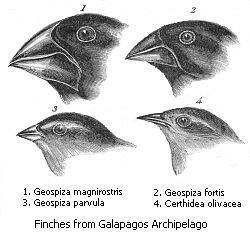 | ||
Divergent evolution is the accumulation of differences between groups, leading to the formation of new species.
The term can also be applied in molecular biology characteristics, such as to proteins that derive from two or more homologous genes. Both orthologous genes (resulting from a speciation event) and paralogous genes (resulting from gene duplication) can be said to display divergent evolution. Because of the latter, it is possible for divergent evolution to occur between two genes within a species.
Similarities between species that have diverged is due to their common origin, so such similarities are homologies. In contrast, convergent evolution arises when an adaptation has arisen independently, creating analogous structures such as the wings of birds and of insects.
Usage
J. T. Gulick (1832-1923) was the first to use the term "divergent evolution"
Divergent evolution occurs when a structure with a common origin is adapted in different ways in different lineages, as with vertebrate forelimbs which now form paddles in whales, wings in bats, hands in primates, and running legs in horses. Divergent evolution similarly split the human lineage from chimpanzees.
Darwin's finches provide a good example of divergent evolution, where some 15 species diverged from a single species of finch that arrived on the Galapagos islands.
The divergent evolution of wolves and domesticated dogs from a common ancestor, perhaps the grey wolf, provides another example. Recent studies of the mitochondrial DNA of wolves and of domesticated dogs have found great divergence while also supporting the hypothesis that dogs descend from wolves.
Speciation, the divergence of one species into two or more descendant species, occurs when a part of the species is separated from the main population by a reproductive barrier. In allopatric and peripatric speciation, the reproductive barrier is the result of a physical barrier (e.g. flood waters, mountain range, deserts). Once separated, the species begins to adapt to their new environment via genetic drift and natural selection. After many generations and continual evolution, the populations become unable to interbreed with one another.
